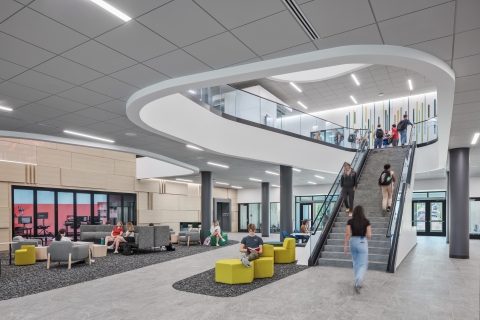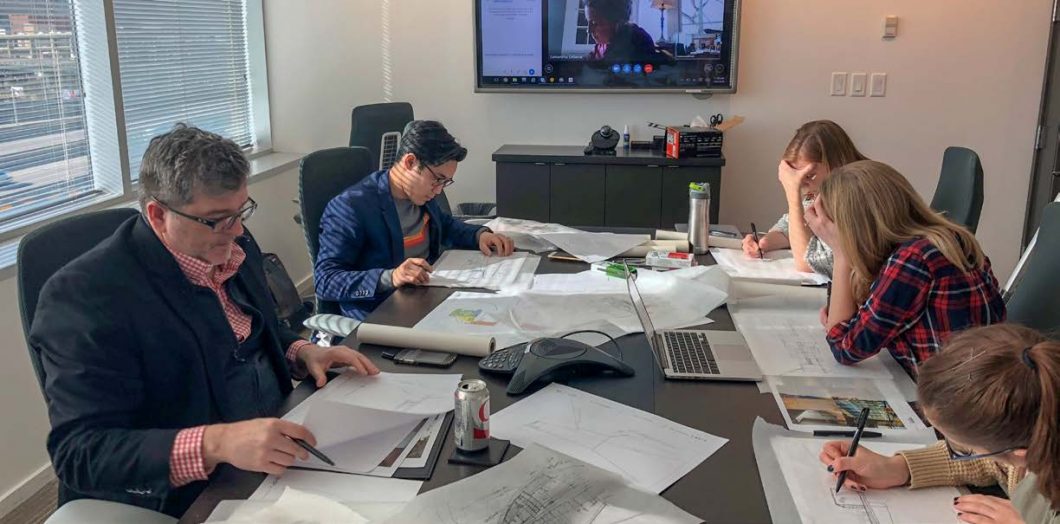
Convergence Teams: The Power of Integrated Design

The benefits that an integrated design process can bring to building projects have been accepted for decades. Assembling a team with diverse expertise to collaboratively work on a project is intuitively understood to be a better approach than designing in a linear, sequential and isolated manner. Tapping people from multiple disciplines (architects, designers, owners, etc.) with a range of perspectives and bringing them together breaks down silos and provides opportunities for communication, collaboration, and issue resolution. When architects, designers, engineers and others work separately on each element of a building, individual goals tend to trump overall project objectives.
Of course, understanding the benefits of integrated design is not the same as realizing them. Implementation is critical. BHDP, a leading workplace design firm, and Fifth Third Bancorp, a diversified financial services company and one of the largest banks and money managers in the country, have worked on a variety of building projects — from discrete offices to the re-development of an entire corporate campus — using an intentional, integrated design approach. The experience has uncovered eight keys to doing integrated design successfully – all revolving around what we call “convergence teams.” Points 1-5 focus on how to form these teams successfully. Points 6-10 highlight how the teams need to work differently in order to truly succeed.
1) Diversity of People: Having people from multiple disciplines is essential.
The first step in delivering design in a truly integrated fashion is ensuring that the right people in the right roles on the project team are in the room. A convergence team of architects, interior designers, environmental graphics experts, and customer experience strategists, consulting with users and the support staff who will be impacted by the workplace design, should all be involved. Having representatives from each of these groups allows decisions to be made more quickly and collaboratively and ensures that the space created will support all of the behaviors engaged in throughout the day.
The core convergence team for Fifth Third and BHDP consists of design, real estate and project leaders from the bank and architecture, interior design and environmental graphics practice leads from BHDP. Others typically consulted – depending on the project – include Fifth Third facility managers, building maintenance, security and re-location professionals.
2) Diversity of Thought: Having people with cross-disciplinary experience is even better.
As important as including people from a broad range of disciplines on the convergence team is encouraging a diversity of thinking and experience. Two of the convergence team members from BHDP have significant retail design expertise. In retail, the focus is always on the customer journey – not just leading the user through a space, but creating moments of discovery. This emphasis on the user experience has influenced the workplace designs at Fifth Third. Other individuals have been able to lend design insights from their experience in markets such as education.
3) Trust and Camaraderie are Essential.
Trust and camaraderie are the fuel of a high-functioning integrated design team. Without this affinity, success will be elusive. That doesn’t mean, by the way, that very passionate people with strong personalities are an issue. Or that creative conflict is a problem. It’s just critical that team members be able to leave their egos at the door and engage in an open-minded, iterative process, learning from each other as they go.
Design firms and clients can develop adversarial relationships based on different priorities. Successful convergence teams treat clients as integral members and work hard to understand their pain points and proactively respond to them. Meanwhile, the ideas of design firm members are always taken seriously and treated with respect, even when they’re not adopted. The bottom line: convergence team members have each others’ backs and are “in it” together.

4) The Right Attitude is as Important as Having the Right Participants.
In addition to trust, successful convergence teams always strive for an attitude (or angle of approach) that there isn’t anything we – collectively – can’t do. Excellence comes from the sum of talents at the table, not from any individual. And it requires certain attributes of the team including:
- Integrity – the recognition that we’re going to make mistakes; we have to own those mistakes and face challenges head on.
- Compassion – to be most effective, we need to walk in each others’ shoes.
- Flexibility or “Door Number Three” Mentality – if our plans don’t work, it’s not the end of the world, it’s the beginning of another opportunity; adaptability and creativity are the key to getting what we collectively want within the constraints we face.
- Humility – we’re experts but we don’t know everything; we have to strive to know what we don’t know and design with humility.
5) Senior Management (at Both the Client and Design Firm) Should be Aligned.
The trust and attitude which drives successful convergence teams starts at the top. Principals at the client and design firm should have a clear understanding of project objectives and share a similar approach to design. A commitment to co-creation is critical along with philosophical and practical alignment on overall goals and design approach.
How can a client ensure that this philosophical alignment exists? Consider refining the RFP process to focus less on case studies and capabilities and more on design thinking, listening skills, and how design team members will be selected.
6) Search and Seek – Search out the Right People to Engage – then Seek to Understand Them.
Once a convergence team is chosen, it should seek out the right people to develop a clear and deep understanding of project parameters, including workplace users: who they are, what they do, their goals and vision for the project. Clear, upfront agreement on these things helps the convergence team benchmark its efforts against a shared strategy. Although every successful integrated design project is, in some respects, a process of self-discovery, it is also important to come to the table with as much information as possible.
7) Meet More Often and Make it Informal.
Making fully informed decisions requires the right people being in the same room. It’s the best way for convergence teams to give and get feedback. At the start of their work together, BHDP and Fifth Third decided to meet every other week but found this wasn’t enough to manage the workflow and back and forth. Now, the team meets every week for four to five hours. The core design team within BHDP also meets at least three times per week as a smaller group.
These meetings are “pens in hands” sessions – they are not particularly formal. In fact, minimizing presentations and thinking of team meetings as working sessions is probably best. And not every member of the wider team needs to be at every meeting – only those that will find it useful.
8) Create the Time and Space to Learn.
Having the leeway to learn by doing can advance both the pace and performance of a convergence team. Micromanagement, on the other hand, is anathema to integrated design. A “no fear” environment is essential. If team members are afraid of making mistakes, they won’t take the risks necessary to find the optimum solutions. You empower a convergence team to succeed by trusting that they will.
9) Strive for Client Intimacy.
A major benefit of investing the time and resources in convergence teams is their ability, through extended collaboration, to establish client intimacy. Design projects become not discrete tasks but part of a holistic effort that emphasizes and extends the client’s culture across a range of workspaces. The experience also enables the client to buy into the concept that successful design is more than staying within budget and meeting schedules – although both of those are important. It is a process, an attitude, a mode of learning.
A “no fear” environment is essential. If team members are afraid of making mistakes, they won’t take the risks necessary to find optimum solutions.
10) Encourage Client Leadership.
In addition to learning, the willingness of the client lead to encourage, collaborate with, and quarterback the team can’t be overvalued. When the client is fully invested in the convergence team and his/her role as the corporate storyteller, other members feel “led from beside” (tugged and nudged forward rather than pushed and pulled). This leads to continual striving for better solutions.
The client lead can also be an important advocate for the convergence team within his or her organization. People within a client company can have unrealistic expectations about budgets or timelines be-cause they’re not designers. The client lead on the convergence team can be a necessary buffer to en-sure that the full team has the latitude necessary to do the best work.
One might assume that because of the attention paid to time spent together that a true, integrated design process driven by convergence teams would cost more and last longer. Our experience suggests otherwise. By focusing on project outcomes versus individual goals and sharing knowledge from the get-go, changes in direction can be identified earlier in the design process, budgets can be better managed, and project timelines can be compressed.
The decisive factors are getting the right people with the right characteristics on the convergence team (Points 1-5) and getting them to work more intelligently through the integrated design process (Points 6-10).

